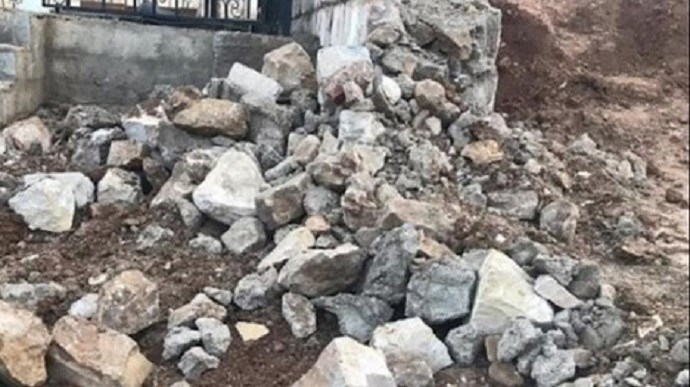Reporting by PMOI/MEK
Iran, December 20, 2020—Plainclothes agents of the Iranian regime destroyed the grave of wrestling champion and political prisoner Navid Afkari on Thursday, December 17. Afkari was arrested in 2018 in relation with widespread anti-regime protests in Fars province. He was brutally tortured by prison authorities and sentenced to death on bogus charges. Despite an international campaign calling for the revocation of Afkari’s death sentence, the regime proceeded with the execution in September, triggering a wave of national and international outrage.
Since his execution, Navid Afkari has become a national hero, and his gravesite as well as those of other executed prisoners have become a frequent point of rally and reunion for many Iranians who are fed up with the tyranny of the Iranian regime. Gatherings at his grave were usually accompanied with anti-regime slogans and vows to take revenge from those who have murdered Iran’s youth for more than four decades.
September 17 – #Iran
Family members and friends of #NavidAfkari gathered at his grave for a ceremony in his memory.
People are heard shouting: "Navid the champion!" pic.twitter.com/IGTwutsKXi— People's Mojahedin Organization of Iran (PMOI/MEK) (@Mojahedineng) September 18, 2020
Having a zero-tolerance policy for dissent, the regime proceeded with destroying Afkari’s grave, located in Sangar, Fars province, hoping that it would deter the people for gathering and commemorating him.
Hours before destroying the grave, security forces arrested Hossein and Hamid Afkari, Navid’s father and brother, and transferred them to an unknown location. The picture of Navid’s demolished grave was first posted by his sister Elham Afkari on Instagram. “This is not a war zone. This is Navid’s grave, which they demolished and took away.”
According to reports, security forces had pressurized the Afkaris to refrain from installing a tombstone for Navid after his execution.
Vahid and Habib Afkari, Navid’s two other brothers who have also been in prison since 2018, were transferred to solitary confinement after his execution.
Mrs. Maryam Rajavi, the president-elect of the National Council of Resistance of Iran (NCRI), condemned the heinous act and described it as a vain attempt by the regime to “extinguish the flames of protests.”
“Justice will not let go of the criminal mullahs’ regime,” Mrs. Rajavi added.
The clerical regime tries in vain to extinguish the flames of protests by destroying the tombs of #NavidAfkari & other martyrs. Just as the victims of the #1988Massacre became famous despite destruction of their graves. Justice will not let go of the criminal mullahs’ regime. pic.twitter.com/dfOLjlYllF
— Maryam Rajavi (@Maryam_Rajavi) December 19, 2020
Meanwhile, Jamal Javadi Jahromi, the governor of the county where Navid’s grave was located defended the outrageous act of destroying the political prisoner’s grave, and told the official IRNA news agency that the tomb was not made by the standards and conventions and deserved to be destroyed.
The Iranian regime has a dark history of demolishing graves of executed political prisoners. In 1988 regime authorities executed more than 30,000 political prisoners under direct orders of then-supreme leader Ruhollah Khomeini. In order to hide the trace of this crime against humanity, the regime buried the bodies in mass unmarked graves in secret locations. But as evidence of the executions and the burial sites cropped up, the unmarked graves of the political prisoners became regular rally points for dissidents. The regime has since gone to great lengths to destroy evidence of its crimes by launching construction projects on the gravesites of political prisoners.





